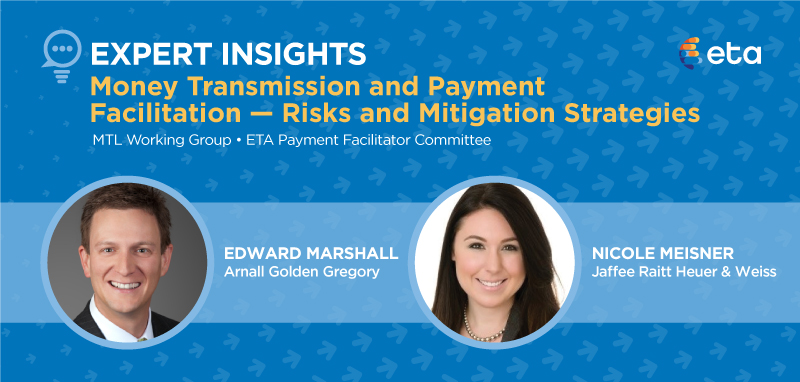ETA Expert Insights: Money Transmission and Payment Facilitation — Risks and Mitigation Strategies

By Edward Marshall, Partner, Arnall Golden Gregory LLP
Nicole Meisner, Partner, Jaffe Raitt Heuer & Weiss, P.C.
MTL Working Group • ETA Payment Facilitator Committee
PART ONE OF TWO
The card brands’ introduction of the payment facilitator model brought with it a range of functionalities and potential service offerings that were (and remain) unavailable to independent sales organizations (ISOs). Among them was the payment facilitator’s ability to receive funds on behalf of submerchants. That is, payment facilitators, unlike their ISO counterparts, received card-brand clearance to step directly into the flow of funds.
Initial enthusiasm for this form of direct participation in funds settlement was understandably high. Payment facilitators saw control over settlement not only as a mechanism for monitoring and capturing fees for their services, but also as a way to offer submerchants flexible funding alternatives more tailored to a particular submerchant’s (or vertical’s) needs. It was an additional arrow in the payment facilitator quiver that made the model more attractive, and more competitively advantageous, than its historical analogues.
Over time, however, payment facilitators became aware of material risks associated with exercising this newfound control over funds flow. After all, fidelity to card brand rules is merely one facet of compliance. Laws and regulations also play a part. And when it comes to the movement of money, especially money sent or received on behalf of third parties, a complex range of laws regulating money transmission comes into play. Governments have an interest in ensuring that those entities to which funds are entrusted for transmission, especially transmission from or to individual consumers, adhere to certain standards and maintain financial safeguards. The frustration arises from the number of governments involved.
The federal legal landscape is relatively benign. Under the Bank Secrecy Act (BSA), money services businesses — which, by definition, include money transmitters — must register with FinCEN. The process, however, is not onerous, and both statutory direction and nationwide judicial precedent provide guidance as to whether registration of a particular payments organization may be required. Once federally registered, a money transmitter is subject to various obligations under the BSA, including anti-money laundering (AML) compliance, and is subject to audit.
The states are where things get complicated. Virtually every state has laws and regulations applicable to money transmitters, which typically require licensure, mandate detailed compliance procedures, and impose penalties for violations. If all the state laws were the same, or were at least modeled after the BSA, that would make things manageable. But they’re not. At all. The state laws are inconsistent in their definition of what constitutes money transmission. They have diverse exemptions, and certain potentially useful exemptions, such as the “agent of the payee” exemption, have not been codified in every state. The licensure and compliance requirements are anything but uniform and, in many instances, can be laborious. And penalties for violations run the gamut from the regulatory slap on the wrist to the existential (and even criminal). Indeed, there have been examples in recent memory where regulatory targets faced painful statewide cease and desist orders (think New York, California, and Texas) and sizable monetary penalties for violations.
Were all that not enough, the laws and regulations are far from models of clarity — often employing a fuzzy facts and circumstances rubric — and guidance on their proper application can be sparse. Meanwhile, state regulators vary widely in the aggressiveness with which they police potential money transmitter violations. None are bound by the acts of, or guidance promulgated by, other state’s regulators, giving rise to the unfortunate reality that monitoring compliance effectively requires erecting and vigilantly observing regulatory weather vanes in nearly 50 states and the District of Columbia.
And it’s not just the government regulators that payment facilitators should be concerned with. Payment facilitators that are operating as unlicensed money transmitters are undoubtedly operating in breach of their sponsor agreement and the card brand rules by failing to comply with applicable laws and regulations. The regulatory gray cloud that looms over noncompliant payment facilitators can also significantly impact the valuation and attractiveness of the business when seeking a capital investment or positioning to be acquired.
There is, however, some good news to offer. The ETA’s Payment Facilitator Committee has established a working group of business leaders and counsel from a variety of organizations that have pooled their knowledge, perspective, and experiences to better guide ETA members as they navigate this sometimes-maddening landscape. In in our next article, we will share certain best practices (with a host of lawyerly caveats) that have helped our clients stay on the right side of regulatory scrutiny and avoid enforcement actions.

